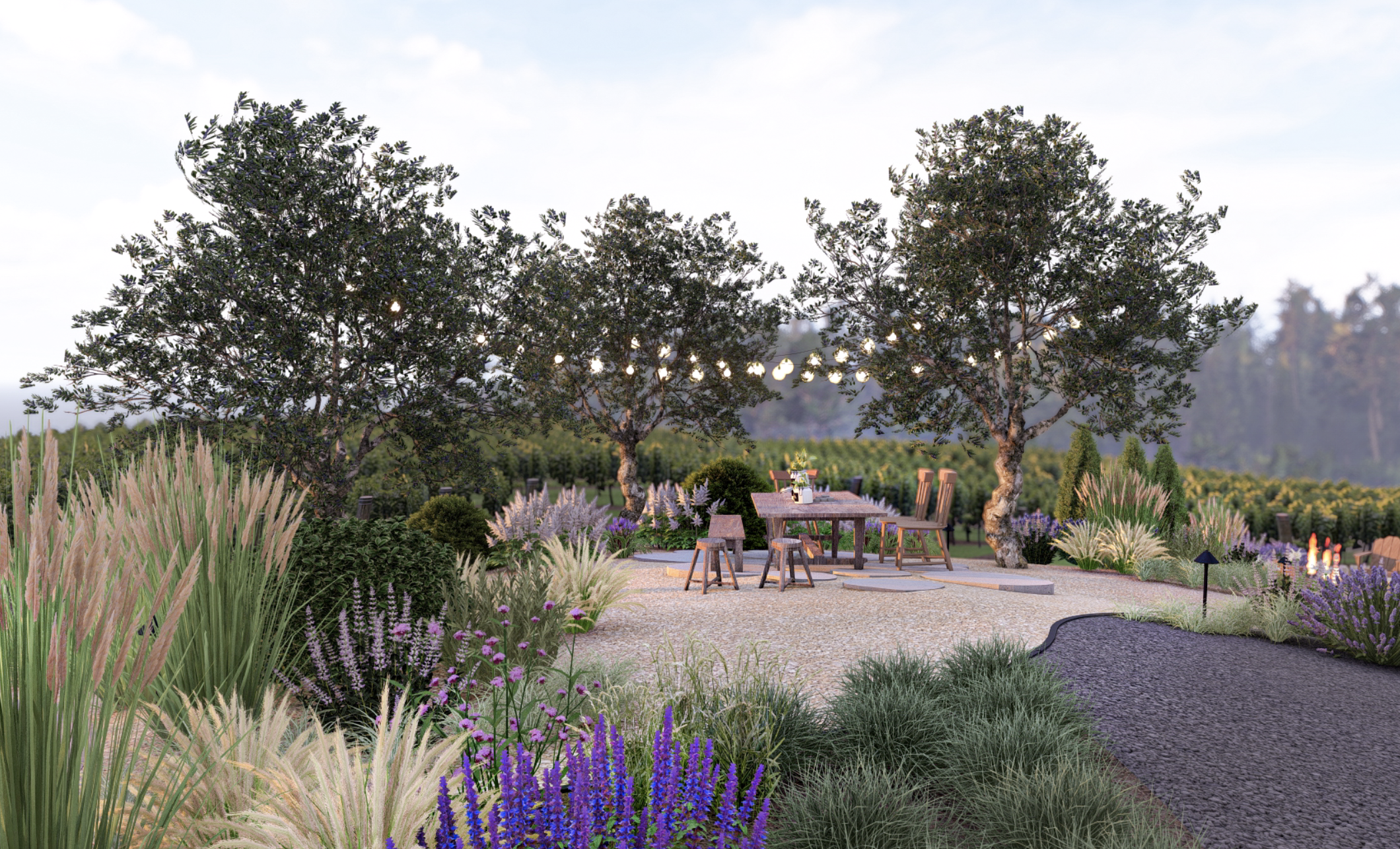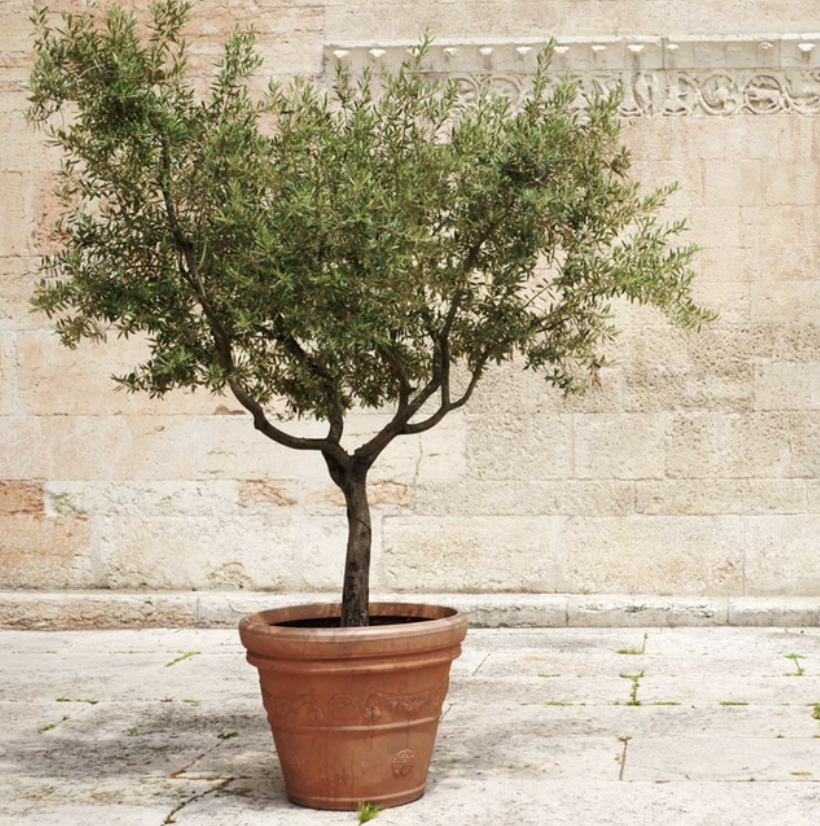A Yardzen design featuring olive trees
Olive trees are one of the most versatile trees in our talented design team’s toolbox here at Yardzen. They can be both fruiting and fruitless, and their elegant form and muted colors adapt to many yard styles, from old world to ultra modern.
Olive trees thrive in a range of climates and conditions. We’ve included varieties here that work well in cool climates, drought conditions, and very poor soil and difficult terrain. Plus, they are extremely low-water, making them a perfect solution for sustainability-minded homeowners. We’ve also included olive trees of different sizes here, from small bushes to very large varieties, making inclusion of an olive tree attainable for any size yard. Plus, if size is an issue, always remember that olives are easily pruned to maintain desired shape and height.
Dreaming of adding an olive tree to your yard? Here are our top recommendations for homeowners based on location, yard size, maintenance requirements, and yard size.
Image via One Kind Design
Types of Olive Trees
Generally, most olive tree varieties bear fruit, but some are fruitless (Wilsoni and Montra) and don’t release pollen, which makes them an attractive option for folks interested in the beauty of an olive tree without the mess (they can be messy during harvest time!). For homeowners interested in making their own olive oils and cured olives, there are several tasty varieties that work beautifully in the yard.
Our Top Picks
Arbequina
Wilsoni
Chemlali
Hojiblanca
Frantoio
Coratina
Leccino
Kalamata
Mission
Montra
Best Olive Trees for Your Yard
Fruitless olive tree (Wilsoni) via Gardenista
Wilsoni
One of our favorite olive trees is the fruitless olive tree. With the same beautiful trunk and leaves as fruiting varieties, these are the perfect option for homeowners who prefer to avoid the maintenance required of fruiting trees. The Wilsoni loves the heat and thrives in drought conditions, so it is especially suited to low-water yards. Zones 8-11.
Beautiful fruit on the Tunisian olive tree variety, Chemlali
Chemlali
The lesser-known Chemlali olive tree is the most compact variety here, making it a great option for smaller yards. This species from Tunisia requires full sun, but it is more cold hardy than most, tolerating zone seven temperatures. The Chemlali is primarily used for olive oil, but it also makes a beautiful addition to the yard. Zones: 7-10.
Montra
Also known as the “Little Ollie” or Dwarf Olive, this species is a fruitless, bush variety perfect for achieving a mediterranean look in a small yard or in pots. The Montra can grow up to eight feet tall, but most people keep them pruned lower to the ground to create hedges and natural borders. This variety is cold hardy down to fifteen degrees, requires full sun, and is drought-tolerant. Zones 8-10.
Hojiblanca
A Spanish variety named for the white backs of the leaves which appear almost iridescent as they flutter in the wind. Culinary enthusiasts revere the Hojiblanca for its fruit, making both wonderful olive oil and table olives. Zones 8-10.
A young Frantoio olive tree via fastgrowingtrees.com
Frantoio
This Italian olive tree is the classic variety you will see throughout Tuscany. This medium-large variety is happy in full or partial sun and tolerates cooler conditions than most, down to 10 degrees, making it a great olive tree for the Pacific Northwest. Zones 7-10.
Mission
First developed in California in the 1700s, the Mission Olive is a historic species and the oldest olive tree variety from the United States. This large variety thrives along the west coast and can be seen in many yards throughout California. It is a high-yield producer, so it is best suited for a homeowner that is interested in using the olives (or is OK with cleaning up after the tree). This variety requires full sun and well-drained soil, although this variety holds up to rocky, poor conditions. This tree is hardy down to 20 degrees. Zones 8-11.
Kalamata
This Greek variety is a classic ingredient in Mediterranean dishes and is an ancient symbol for peace. (“An olive branch.”) This variety is medium-large and requires full sun. Zones 7-10.
Arbequina
The Arbequina olive tree is one of the larger varieties, although it can be kept smaller by pruning. The Arbequina requires full or partial sun. Similar to the climate in Spain, where this species originated, the Arbequina prefers well-drained, alkaline-rich soil. Zones: 8-10.
Leccino
The Italian Leccino is prized for both its large, delicious fruit and its beautiful form with weeping bows and a gnarled trunk. It is a medium-sized variety that likes full, but it is hardy down to 12 degrees. This tree starts to bear fruit soon after planting-- in the first year or two--making it a great variety for those who are excited about getting underway with pressing and brining. Zones 8-10.
Coratina
This Italian variety grows well under many soil conditions, including even the most unforgiving terrains. Pressing for olive oil is the most common use for these trees, although they are a great option for yards with very poor soil. Zones 8-11.
How to harvest olives
Once the olives are ripe, picking them is fairly straightforward and can be done by hand. Depending on the type you plant, olive tree harvests run from late August through November. When you pick the olive depends on what you plan to do with the fruit. Mid-season olives are best for oils while late-season harvests are best for brining.
DESIGNING A LANDSCAPE TAILORED TO YOUR NEEDS
Yardzen's award-winning online landscaping design is tailored to each of our client's local climate and design preferences. Our design process begins with understanding your space, aesthetic preferences, and a discussion of your budget and vision to minimize surprises when it comes time to build. We want to make sure our top-notch designers can personalize your yard, delivering 3D and CAD renders that reflect what’s most important for your outdoor life and unique environment, while keeping costs within range. We do this by utilizing our in-house Build Team made up of former contractors and our Pro Network of vetted professional landscapers across the country.
Ready to level up your home improvement with a professional landscape design? Create your design profile or explore our design packages today!







